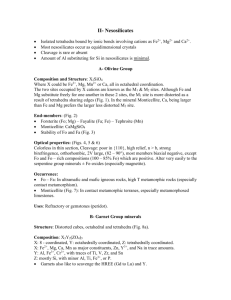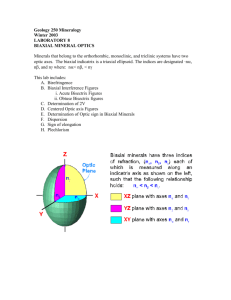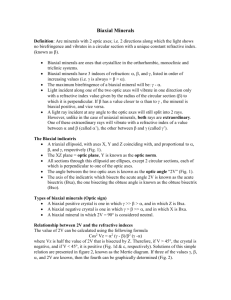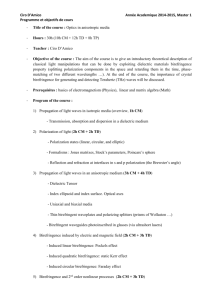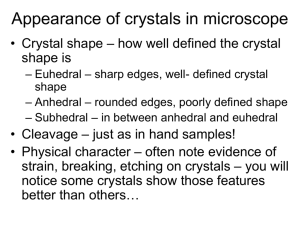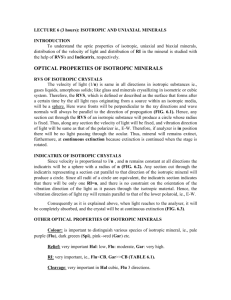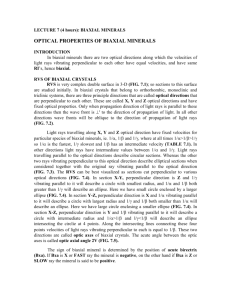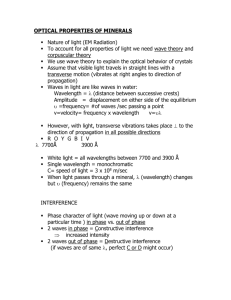Mineralogy Lecture Ch13 Lecture 21
advertisement
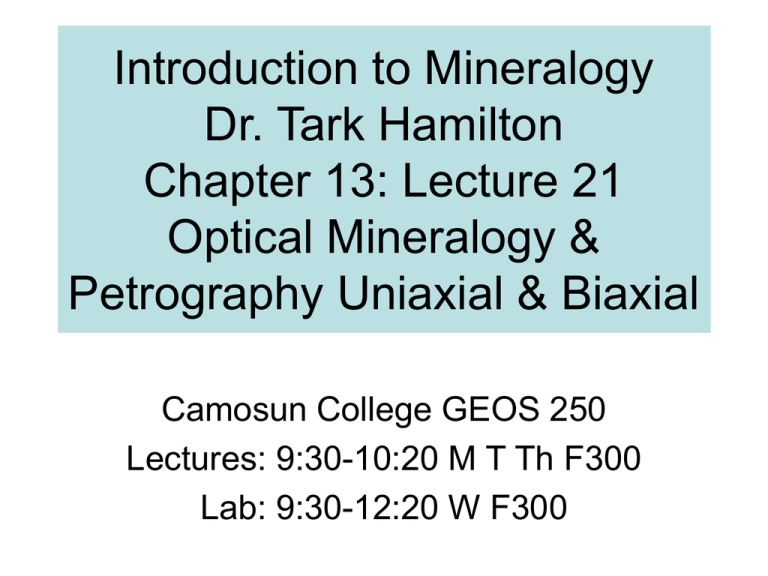
Introduction to Mineralogy
Dr. Tark Hamilton
Chapter 13: Lecture 21
Optical Mineralogy &
Petrography Uniaxial & Biaxial
Camosun College GEOS 250
Lectures: 9:30-10:20 M T Th F300
Lab: 9:30-12:20 W F300
Optical Indicatrix of Uniaxial Crystals
(hexagonal, tetragonal)
Prolate
Ellipsoid
Oblate
Plane of
Circular section
nω < nε , cω > cε
Optically positive
fig_13_13
nω > nε , cω < cε
Optically negative
Elliptical Section has “C” Axis
Plane of Extraordinary Ray
Elliptical Section
Single
Refraction
Double
Refraction
Plane of Ordinary Ray
Circular Section
positive
negative
2 special vibration directions in crystal: basal plane & its normal
fig_13_14
Vibration Directions & Extinction Positions
A-A Analyzer
(Switch by ocular)
P-P Substage Polarizer
Illumination has the
Vector sum of vibration
Directions passing the
Analyzer.
Maximum illumination
In 45° position
fig_13_15
Extinction occurs when the crystal vibration direction
Equals that of the polarizer & is blocked out by the analyzer
Birefringence in Uniaxial Crystals
• Birefringence depends on the difference in refractive
indices and the path length (mineral thickness), so bigger
crystals look prettier than little ones under crossed polars
• This is the same as the amount of double refraction
• For the principle or flash section the 45° position of
maximum illumination shows the full value δ=[ω-ε]
• For other random inclinations (tilts other than vertical)
birefringence is less because δ=[ω-ε’]
• δ is low for Quartz & Apatite, Extreme for Zircon & Calcite
Uniaxial Interference Figures
for Conoscopic Light & High Power
ε-ray vibrates radially
ω-ray vibrates tangentially
Concentric isochromatic curves
W Is Tangential To Isochrome
Low Birefringence
δ < 0.02
Grey, white 1st yellow
Quartz, Feldspar, Clays Feldspathoids
Hi Birefringence
δ > 0.03
Blue, green, hot pink
Muscovite, Epidote
fig_13_16
Off-Centered Uniaxial Optic Axis Figure
& Clockwise Rotation of Stage
Isogyre arms of Black Cross are extinction directions.
When the “C” Axis isn’t vertical,
The Isogyres remain N-S & E-W
But the center precesses around the origin.
Conoscopic illumination
Causes flaring of isogyres
fig_13_17
Determining Optic Sign from Optic Axis Figure
ε-ray is slow for optically + so colours increase:
Isochromatic curves move in in quadrants I & III
Accessory Plates: ¼ wave mica,
rot-1 gypsum & quartz wedge
are all length fast
Slow + Fast = Subtraction
In I & III for Optically fig_13_18
Optic Sign for some Uniaxial Minerals
Mineral
ω
ε
δ = birefringence
Nepheline
1.537 1.534 0.003 Dark grey Negative
Quartz
1.544 1.553 0.009 White
Positive
Apatite
1.649 1.644 0.005 Grey
Negative
Optic sign
Calcite
1.658 1.486 0.172 High White Negative
7th order colour
Corundum 1.769 1.760 0.009 White
Negative
Zircon
1.920 1.967 0.047 3rd order Positive
Colour Changes for Uniaxial
Minerals with Rot-I Plate
fig_13_19
Sign of Elongation: (small crystals
typically have low-grey birefringence) {δ=ω-ε}
Grain orientation
Not quadrant
E-ray is fast, optically Negative elongation length fast
Grey + Red = Blue
Slow + slow = add
E-ray is slow, optically +
Positive elongation length slow
Grey - Red = Yellow
Slow + fast = subtract
Uniaxial (Hexagonal & Tetragonal) Crystals with elongation
Controlled by growth forms or prismatic cleavages often have
Optical directions that coincide with crystallographic ones.
fig_13_20
Biaxial Minerals: Orthorhombic,
Monoclinic & Triclinic
Index
Relative value
Alpha=nx=nα α-Lowest
Direction Ray
Velocity
X
Fastest
Beta=nY=nβ
β-Intermediate
Y
Intermediate
Gamma=nγ
γ-Highest
Z
Slowest
Biaxial + Indicatrix: Z=Bxa
β is closer to α than to γ
β is intersection
of circular sections
Y is the Optic Normal
Optic Axes
Circular
Sections
90° to OAs
Optic Plane = ZX
Flash Figure, δ=γ-α
Maximum Birefringence
fig_13_21
2V: The Optic Angle in Biaxial Crystals
• Light moving along the Optic Axes in Biaxial
Crystals has n=β and no birefringence
• 2V is the angle between the Optic Axes of
which Z is the Acute Bisectrix (Z=Bxa) for +
• V the optic angle is related to the shape of the
indicatrix and thus the 3 indices of refraction
• Cos2Vx = [ γ2(β2-α2) / β2(γ2-α2) ], where V is Bxo
• Cos2V’x =~ (β-α) / (γ-α)
• V’ < V not accurate for large V, δ birefringence
• Since V is for Bxo, V<45° is negative, V>45° +
Optical Orientation Diagrams for
Special Sections of Barite (mmm)
Parallel
extinction
Symmetric
extinction
Cleavage sections
Z Λ c = 53°
Inclined Extinction
In Optic Plane (010)
Or Flash Section
fig_13_22
Biaxial Crystals in Convergent
Polarized Light
Bxa Interference Figures
Parallel Extinction Position
Melatopes
45° Position Maximum Illumination
2V ~ 45, Field of view = 60°
fig_13_23
Apparent Optic Angle (2E > 2V)
2E increases as β increases
2V looks too big on Bxa
Melatopes too far apart
fig_13_24
Curvature of Isogyre: Centered Optic Axis Figure
2V
fig_13_25
Optic Sign tests for -Bxa & OA
fig_13_26
Optical Properties of Biaxial Minerals
Mineral
α
β
γ
δ
Sign
Stilbite
1.494
1.498
1.500
0.006
-
Gypsum
1.520
1.523
1.530
0.010
+
Sanidine
1.521
1.526
1.528
0.007
-
Muscovite
1.556
1.602
1.603
0.047
-
Forsterite
1.635
1.651
1.670
0.035
+
Epidote
1.733
1.755
1.765
0.032
-
Other Optical Properties
• Absorption e.g. X>Y>Z (intensity varies in
any light)
• Pleochroism e.g. Straw-Yellow-Brown,
Pale Green-Olive-Green Brown (colour
varies with crystal orientation, Fe
minerals, only in Plane Polarized Light)
• Cleavage, Habit, Twinning, Zoning, Z Λ C,
inclusion patterns, radiation haloes,
metamict, alteration phases
Reflected Light Microscopy
Isotropic
Anisotropic-bireflectance
Intensity, colour
oil immersion
Microindentation hardness
fig_13_27

